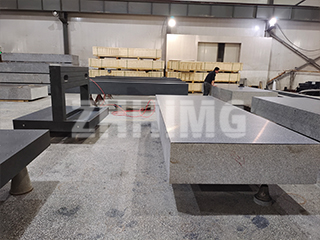In the field of precision machinery and measuring equipment, when a single granite component fails to meet the needs of large – scale or complex structures, splicing technology has become the core method to create ultra – sized components. The key challenge here is to achieve seamless connection while ensuring overall precision. It is necessary not only to eliminate the impact of splicing seams on structural stability but also to control the splicing error within the micron range, so as to meet the strict requirements of equipment for the flatness and perpendicularity of the base.
1. Precision Machining of Splicing Surfaces: The Foundation of Seamless Connection
The seamless connection of granite components starts with the high – precision machining of splicing surfaces. First, the splicing surfaces are subjected to plane grinding. Multiple rounds of grinding are carried out using diamond grinding wheels, which can control the surface roughness within Ra0.02μm and the flatness error to no more than 3μm/m.
For rectangular spliced components, a laser interferometer is used to calibrate the perpendicularity of the splicing surfaces, ensuring that the angle error of adjacent surfaces is less than 5 arcseconds. The most critical step is the ”matched grinding” process for the splicing surfaces: two granite components to be spliced are attached face – to – face, and the convex points on the surface are removed through mutual friction to form a micro – level complementary and consistent structure. This “mirror – like bonding” can make the contact area of the splicing surfaces reach more than 95%, laying a uniform contact foundation for the subsequent filling of adhesives.
2. Adhesive Selection & Application Process: Key to Connection Strength
The selection of adhesives and their application process directly affect the connection strength and long – term stability of spliced granite components. Industrial – grade epoxy resin adhesive is the mainstream choice in the industry. After mixing with a curing agent in a certain proportion, it is placed in a vacuum environment to remove air bubbles. This step is crucial because tiny bubbles in the colloid will form stress concentration points after curing, which may damage the structural stability.
When applying the adhesive, the “doctor blade coating method” is adopted to control the adhesive layer thickness between 0.05mm and 0.1mm. If the layer is too thick, it will lead to excessive curing shrinkage; if it is too thin, it cannot fill the micro – gaps on the splicing surfaces. For high – precision splicing, quartz powder with a thermal expansion coefficient close to that of granite can be added to the adhesive layer. This effectively reduces the internal stress caused by temperature changes, ensuring that the components remain stable in different working environments.
The curing process adopts a step – by – step heating method: first, the components are placed in an environment of 25℃ for 2 hours, then the temperature is increased to 60℃ at a rate of 5℃ per hour, and after 4 hours of heat preservation, they are allowed to cool naturally. This slow curing method helps to reduce the accumulation of internal stress.
3. Positioning & Calibration System: Core of Overall Precision Assurance
To ensure the overall precision of spliced granite components, a professional positioning and calibration system is indispensable. During splicing, the ”three – point positioning method” is used: three high – precision positioning pin holes are set at the edge of the splicing surface, and ceramic positioning pins are used for initial positioning, which can control the positioning error within 0.01mm.
Subsequently, a laser tracker is used to monitor the overall flatness of the spliced components in real – time. Jacks are used to fine – tune the height of the components until the flatness error is less than 0.005mm/m. For ultra – long components (such as guide bases over 5 meters), horizontal calibration is carried out in sections. A measuring point is set every meter, and computer software is used to fit the overall straightness curve, ensuring that the deviation of the entire section does not exceed 0.01mm.
After calibration, auxiliary reinforcement parts such as stainless steel tie rods or angle brackets are installed at the splicing joints to further prevent relative displacement of the splicing surfaces.
4. Stress Relief & Aging Treatment: Guarantee for Long – term Stability
Stress relief and aging treatment are crucial links to improve the long – term stability of spliced granite components. After splicing, the components need to undergo natural aging treatment. They are placed in a constant temperature and humidity environment for 30 days to allow the internal stress to be released slowly.
For scenarios with strict requirements, vibration aging technology can be used: a vibration device is used to apply low – frequency vibration of 50 – 100Hz to the components, accelerating stress relaxation. The treatment time depends on the quality of the components, usually 2 – 4 hours. After aging treatment, the overall precision of the components needs to be re – tested. If the deviation exceeds the allowable value, precision grinding is used for correction. This ensures that the precision attenuation rate of the spliced granite components does not exceed 0.002mm/m per year during long – term use.
Why Choose ZHHIMG’s Granite Splicing Solutions?
With this systematic splicing technology, ZHHIMG’s granite components can not only break through the size limitation of a single piece of material but also maintain the same precision level as integrally processed components. Whether it is for large – scale precision instruments, heavy – duty machine tools, or high – precision measuring platforms, we can provide stable and reliable basic component solutions.
If you are looking for high – precision, large – sized granite components for your industrial projects, contact ZHHIMG today. Our professional team will provide you with customized splicing solutions and detailed technical support, helping you improve the performance and stability of your equipment.
Post time: Aug-27-2025

